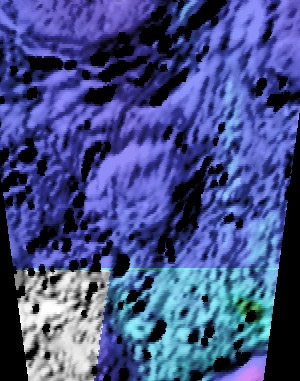Brashear
Contents
Brashear
| Lat: 73.8°S, Long: 170.7°W, Diam: 55 km, Depth: km, Rükl: (farside) | |
Images
LPOD Photo Gallery Lunar Orbiter Images Apollo Images
Maps
(LAC zone 141C2) USGS Digital Atlas PDF
Description
Brashear crater lies just south of Antoniadi -- a 143 kilometre-wide crater of the Late Imbrium period (~ 3.85 to 3.75 bn years). Its rim appears very old as it looks well-worned down, however, as the above nearby crater is so close, we're probably looking at a crater that has been covered in ejecta deposits from that impact. The floor appears, thus, non-existant, but several smaller impact craters are seen covered by the afore-metioned ejecta deposits. In all, Brashear remains a comparatively normal, bowl-shaped crater, however, the overlain ejecta deposits has made its appearance look somewhat more shallower.
Description: Wikipedia
Additional Information
Nomenclature
John Alfred Brashear (November 24, 1840 - April 8, 1920) was an American astronomer and instrument builder. Beginning in 1861 he worked as a millwright in a rolling mill in Pittsburgh, where he pursued his love for astronomy at night, with the help of his wife Phoebe. He had little means and could not purchase a telescope, so he built his own workshop behind his house to construct his own instrument. It took him 10 years to complete and was operating in 1874. He eventually donated the telescope to the University of Pittsburgh's Allegheny Observatory. Starting in 1880 he dedicated his time to the manufacture of astronomical as well as scientific instruments, and performed various experiments. He developed silvering methods that would become the standard for telescope mirrors, but never patented his techniques. He founded "John Brashear Co." and his instruments gained worldwide respect. The modern optical firm long known as "Contraves Corp." now bears his name. Optical elements produced by John Brashear were used at Lick Observatory and Lowell Observatory.
LPOD Articles
Bibliography
J. E. Brashear in the Sourcebook Project (William R. Corliss)
- In Mysterious Universe, a handbook of astronomical anomalies (1979) :
- Page 93: The Ring of Light surrounding Venus (J.E.Keeler, Sidereal Messenger, 1883).

